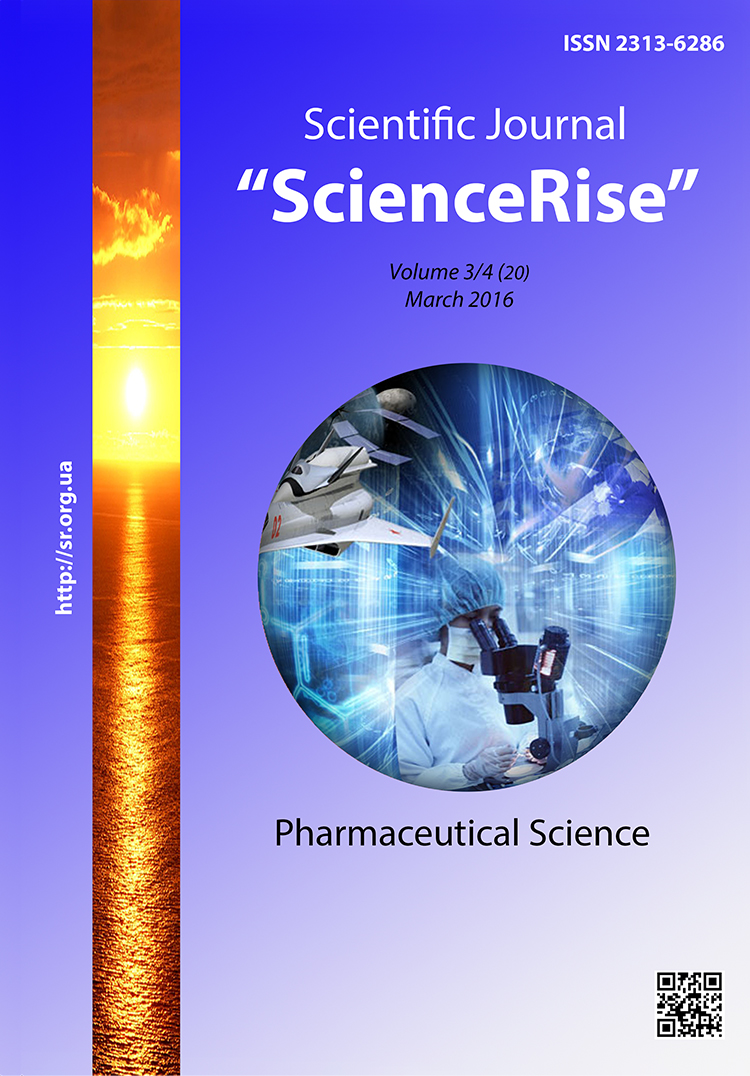Antiglaucoma pharmacotherapy: analysis of treatment regimens and efficacy indicators
DOI :
https://doi.org/10.15587/2313-8416.2016.65160Mots-clés :
primary open-angle glaucoma, the efficacy of pharmacotherapy, intraocular pressure, treatment regimens, antiglaucoma medicinesRésumé
The purpose of this paper is to assess regimens administered for treatment of primary open-angle glaucoma in terms of their compliance with the Protocol of medical care to appropriate group of patients, as well as assessment of the therapy efficacy by the criterion of a degree of intraocular pressure reduction.
Research methods. The study was conducted on the basis of data received from outpatients diagnosed "primary open-angle glaucoma". 49 different variants of medicine combinations, consisting of one to three antiglaucoma medicines in the pharmaceutical form of eye drops were prescribed to patients from the subject group.
Results of the study. The eight most commonly prescribed regimens consisted primarily of first-line medicines for glaucoma pharmacotherapy. Five of eight subject regimens consisted in monotherapy and only three regimens consisted of two medicines. Also, we calculated a degree of IOP decrease in patients received the above treatment regimens compared with baseline IOP indicators, established at diagnosis stage. It was found that the most effective regimens were the ones containing Arutimol 0.5 %, or Azopt in combination with Taflotan. The study of distribution of regimens containing antiglaucoma medicines, depending on the POAG stage, demonstrated that patients with a stage I disease were administered monotherapy, whilst combined regimens were used mainly for treatment of patients with stage III POAG.
Conclusion. The results of the analysis allowed us to determine the most commonly prescribed regimens of antiglaucoma therapy, effective in reaching the target IOP, which consequently would be used for pharmacoeconomic analysisRéférences
Global Initiative for the Elimination of Avoidable Blindness: action plan 2006–2011 (2007). World Health Organization. Available at: http://www.who.int/blindness/Vision2020_report.pdf
Volkov, V. V. (2008). Glaukoma otkrytougol'naja. Moscow: MIA, 352.
Pasjechnikova, N. V., Rykov, S. O., Vitovs'ka, O. P. et. al (2009). Social'ni aspekty poperedzhennja slipoty, organizacija medychnoi' dopomogy ta reabilitacija hvoryh na glaukomu. Kyiv: TOV “Doktor-Media”, 172.
Duglas, Dzh. R. (2010). Glaukoma. Moscow: GJeOTAR-Media, 472.
Pro zatverdzhennja ta vprovadzhennja medyko-tehnologichnyh dokumentiv zi standartyzacii' medychnoi' dopomogy na zasadah dokazovoi' medycyny (2011). Nakaz MOZ Ukrai'ny vid 23.11.2011; № 816. Available at: http://www.moz.gov.ua/ua/portal/dn_20111123_816.html
Nesterov, A. P. (2008). Glaukoma. Moscow: Medicinskoe informacionnoe agentstvo, 360.
Rykov, S. O., Shpak, G. V., Lavryk, N. S. et. al; Rykov, S. O. (Ed.) (2013). Organizacija oftal'mologichnoi' dopomogy. Normatyvno-pravove zabezpechennja: dovidnyk likarja "Oftal'molog". Kyiv: Biblioteka "Zdorov'ja Ukrai'ny", 498.
Damji, K. F., Freedman, S., Moroi, S. E. (2010). Shields’ Textbook of Glaucoma. Lippincott Williams & Wilkins, 656.
Terminology and guidelines for glaucoma (2008). European Glaucoma Society. Savona: Publicomm srl., 184.
Vorob'ev, P. A., Avksent'eva, M. V., Jur'ev, A. S. et. al (2004). Kliniko-jekonomicheskij analiz. Moscow: Izdatel'stvo «N'judiamed», 404.
Devine, E. B., Hoang, S., Fisk, A. W., Wilson-Norton, J. L., Lawless, N. M., Louie, C. (2009). Strategies to optimize medication use in the physician group practice: The role of the clinical pharmacist. Journal of the American Pharmacists Association, 49 (2), 181–191. doi: 10.1331/japha.2009.08009
Pro zatverdzhennja s'omogo vypusku Derzhavnogo formuljara likars'kyh zasobiv ta zabezpechennja jogo dostupnosti (2015). Nakaz MOZ Ukrai'ny vid 30.03.2015; № 183. Available at: http://www.moz.gov.ua/ua/portal/dn_20150330_0183.html
Téléchargements
Publié-e
Numéro
Rubrique
Licence
(c) Tous droits réservés Olena Kryvoviaz 2016

Cette œuvre est sous licence Creative Commons Attribution 4.0 International.
Our journal abides by the Creative Commons CC BY copyright rights and permissions for open access journals.
Authors, who are published in this journal, agree to the following conditions:
1. The authors reserve the right to authorship of the work and pass the first publication right of this work to the journal under the terms of a Creative Commons CC BY, which allows others to freely distribute the published research with the obligatory reference to the authors of the original work and the first publication of the work in this journal.
2. The authors have the right to conclude separate supplement agreements that relate to non-exclusive work distribution in the form in which it has been published by the journal (for example, to upload the work to the online storage of the journal or publish it as part of a monograph), provided that the reference to the first publication of the work in this journal is included.

